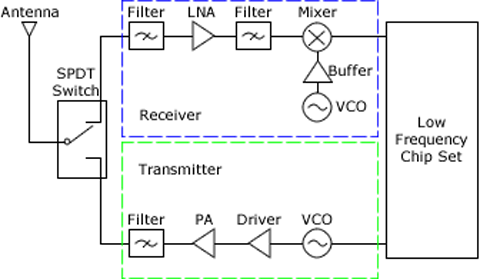Given that part of a distributor’s job is to ease the engineer’s task by providing solutions in application areas of current interest to the design community, Mouser’s launch of a new RF Wireless Technology website certainly warrants the phrase “no brainer” — something obvious or self-explanatory that requires little mental effort or intelligence to understand. After all, according to those charged with tracking industry trends, RFIC market growth is expected to chalk up a 14% CAGR through 2015.

Block diagram navigation further speeds the search of electronic components for design.
Spurred by the expectation of prodigious growth, suppliers developing RF product and processes have been about as eager as a dog outside a butcher shop. But adding hyperactive product development to the large number of unique technologies that already fall under the umbrella of RF/microwave, reviewing recent developments in the RF space on this one page provides a choice between making a few notations on each of a large number of product categories, or exploring notable trends in a couple of key technology drivers. We’ve decided to do the latter and will explore what’s happening in RF switches and power amplifiers.
RF switches are used to switch a signal being routed between two or more devices that share an antenna. There are many types of RF switches, including, single-pole-double-throw (SPDT) and multiport or single-pole-multiple-throw (SPnT), and RF switches can be implemented in technologies ranging from mechanical structures to semiconductor based gallium-arsenide (GaAs) or CMOS FETs. Of the various specifications for RF switches the designer should examine when making a part selection, two stand apart: insertion loss (a measure of power loss in the signal — lowest is best as lower loss at the receive port puts less burden on the subsequent low-noise amplifiers (LNA), and therefore improves receiver sensitivity), and isolation (highest is best, preventing the high power Tx signal leaking into the Rx path).
A relatively new type of switch is the MEMS RF switch, which promises the high RF performance and low dc power consumption of electromechanical switches and the small size and low-cost features of semiconductor designs.
The advantages of RF MEMS switches start with RF performance that is excellent when compared to PIN diode or FET switches, including: very high isolation (RF MEMS switches are fabricated with air gaps, and hence have very low off-state capacitances resulting in excellent isolation); very low insertion loss (RF MEMS switches typically have an insertion loss of 0.1 dB up to 100 GHz); very low power consumption (electrostatic actuation requires 30 to 80 V, but does not consume any current, leading to very low power dissipation).
Disadvantages include relatively low speed (2 to 40 µs for electrostatic MEMS switches and 200 to 3,000 µs for thermal/magnetic actuated switches) and high actuation voltage (thermal/magnetic switches can be actuated using 2 to 5 V, but require 10 to 100 mA of actuation current).
The last output stage in every wireless system includes some form of RF power amplifier (PA) to boost the RF signal as much as possible or allowable just before the signal is sent out over the antenna. Power amplifiers can be fabricated using a variety of technologies including gallium-arsenide (GaAs), indium-gallium-phosphide, silicon-germanium, CMOS, or gallium nitride (GaN).
One of the challenges in PA design is how to achieve linearity without degrading efficiency. Because of its performance in this regime, GaN High-Electron-Mobility Transistors (HEMT) technology is being considered for many applications in which linearity and efficiency are critical. The improvement of output power over competing GaAs and InP technologies can increase operating range, reduce the antenna gain requirement, or provide a combination of the two benefits. GaAs has a basic power density of about 1.5 W/mm, while GaN has a power density ranging from 5 to 12 W/mm. What’s more, GaN has relatively high breakdown voltages levels, up to about 80 V.
Even though GaN has been recognized as a compelling alternative to silicon for many RF applications– because of its performance benefits — it has faced significant challenges related to cost. Those companies pushing GaN say they expect prices will fall as production volumes grow, advances in manufacturing take hold and the technology adapts to more applications. ■
Advertisement
Learn more about Mouser Electronics





